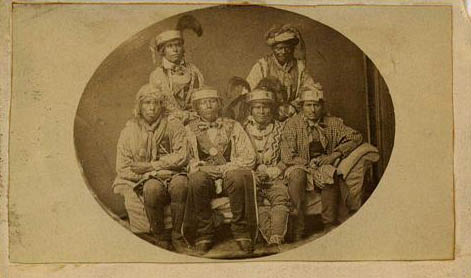
Tuesday, June 1, 2010
Chief Micanopy

Current Events
Monday, May 24, 2010
Government
The Seminole Nation began in the early 18th century, but was not formally recognized as a separate tribe by the United States until 1957. Seminoles today have sovereignty over their own tribal lands and an economy based on tobacco, tourism, entertainment and gambling. The Seminole Nation of Oklahoma, like other Indian nations, retains its own government, laws, police, and services as if it was an independent nation. However, the Seminoles are also US citizens and are required to obey the law of the United States.
The Seminole Nation of Oklahoma's government is made up of two key components, the Executive Office (Executive Branch), and the General Council (Legislative Branch). The Executive Office consists of a Principal Chief, and an Assistant Chief. The Principal Chief and Assistant Chief are similar to a president and vice president, given that they have executive authority to make decisions based on issues presented to them, but the General Council is actually above the Chiefs on the government's organizational structure and they are the ones who bring about the laws.
Links:
Constitution of the Seminole Nation of Oklahoma: http://www.seminolenation.com/government_constitution.htm
Seminole Nation of Oklahoma Code of Laws:
http://www.seminolenation.com/government_codeoflaws.htm
Wednesday, May 19, 2010
ART



Paintings by Noah Billie
Basketry
Beadwork
Dolls



Education
When the Seminole Nation was removed to Oklahoma schools quickly popped up to educate Indian youngsters. By 1906 15 schools were in operation to serve the educational needs of the youngest tribal members.
While the US Federal government supported the schools they wanted to ensure that teachers were not teaching in the Seminole native language nor were they teaching the Seminole children about their native history and culture. Reports during that time period show that school superintendent insisted that teachers focus on teaching girls cooking, sewing and housekeeping and farming, carpentry and care of livestock to boys. For this reason, the Federal government did all it could to prevent the hiring of teachers by the tribe. For their part, the tribe resisted these efforts in order to provide their children with an education that was culturally relevant to tribal children.
Prior to 1900 the vast majority of schools were provided to the tribe via missionaries. While the missionaries may have had the best of intentions, their ultimate goal, conversion to Christianity, served to diminish the cultural and spiritual identity of the tribe. In 1867 the first school for Seminole Indian children was built using Reconstruction funds. The Presbyterian Home Mission Board provided the first teachers with a curriculum strongly focused on teaching English. In these early schools, children attended classes in the morning and returned home to work in the fields in the afternoon.
As time went on, schools became more specialized and in 1891 the Mekasuki (also: Mekusukey or Mekasukey) Academy for Boys opened followed in 1892-1893 by the Emahaka (also: Emahake) Academy for Girls.
Present
Currently the Seminole Nation of Oklahoma embraces primary, secondary and continuing education for its members. In doing so, the tribe offers a variety of educational grants and scholarships for its members with which to pursue college and vocational education. For all educational awards the student must provide the following:
1. Show tribal membership card
2. Show Certificate of Degree of Indian Blood
3. Provide college transcripts once per year
4. Maintain GPA of 2.0
Additionally, the following describe the additional requirements for Vocational and Undergraduate studies.
➢ Vocational School
The tribe allows a maximum award of $2400 to be used toward vocational education. The amount of the award varies based on enrollment status but will not exceed the actual cost of tuition and books. Additionally, the tribe will not award the funds directly to the student but will pay it toward the school. However, if a student can show paid receipts for tuition and/or books the tribe will reimburse the student directly. Finally, students have the option of an additional $100 toward the cost of any vocational licensure.
➢ Undergraduate Education
Educational award for undergraduate students may not exceed $5600 and total amount of award is determined based on undergraduate status i.e. freshman, sophomore, junior, senior, and total number of credit hours taken.
In addition to the standard awards, tribal student may also be eligible to receive an incentive award. In order to qualify for the incentive award a student must take a minimum of 12 credit hours (or equivalent) and maintain a 3.5 GPA or the student must take 15 credit hours (or equivalent) and maintain a 3.0 GPA. In total the incentive award cannot exceed $4000.
Works Cited
McReynolds, Edwin The Seminoles
Jorgenson, Lloyd P. Materials on the History Of Education in State Historical Journals
http://www.seminolenation.com/services_judgmentfund.htm







